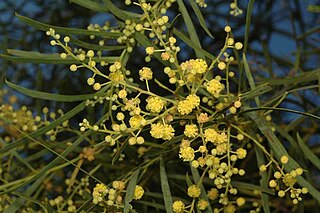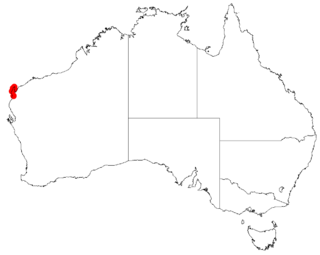
Acacia acanthoclada, commonly known as harrow wattle, is a species of flowering plant in the family Fabaceae and is endemic to southern continental Australia. It is a low, highly branched, spreading and spiny shrub with wedge-shaped to triangular or egg-shaped phyllodes with the narrower end towards the base, and spherical heads of up to 30 flowers, and linear, spirally-coiled pods.

Acacia acinacea, commonly known as gold dust wattle, wreath wattle or round-leaf wattle. is a species of flowering plant in the family Fabaceae and is endemic to south-eastern continental Australia. It is a bushy or straggling shrub with asymmetric, narrowly oblong to broadly egg-shaped phyllodes with the narrower end towards the base, flowers arranged in a spherical heads 4.0–4.5 mm (0.16–0.18 in) in diameter with 8 to 20 flowers, and a spirally coiled to twisted pods up to 3.0–4.5 mm (0.12–0.18 in) long.

Acacia brunioides, commonly known as brown wattle is a species of flowering plant in the family Fabaceae and is endemic to eastern Australia. It is an erect or spreading shrub with more or less cylindrical phyllodes, inflorescenses arranged singly in leaf axils, each with 20 to 27 more or less white to bright yellow flowers, and straight, papery to leathery pods up to 15–60 mm (0.59–2.36 in) long.

Acacia maitlandii, also known as Maitland's wattle, is a perennial tree native to Australia.

Acacia hakeoides, known colloquially as hakea wattle, hakea-leaved wattle or western black wattle, is a species of flowering plant endemic to southern Australia. It is a bushy shrub or tree with lance-shaped to linear phyllodes, racemes of bright golden-yellow flowers and more or less leathery to leathery to hard and brittle pods. It can be found growing in sandy soils in semiarid and Eucalyptus woodland in the region.
Acacia anastomosa, also known as Carson River wattle, is a species of flowering plant in the family Fabaceae and is endemic to northern Western Australia. It is a spindly, staggly shrub with many stems, narrowly elliptic phyllodes, 1 or 2 heads of densely flowered spikes in axils, and narrowly oblong pods.

Acacia areolata is a species of flowering plant in the family Fabaceae and is endemic to the Northern Kimberley region of Western Australia. It is a spreading shrub with curved phyllodes, racemes of one or two spikes of yellow flowers in axils, and narrowly oblong to oblong pods up to 75 mm (3.0 in) long.

Acacia aestivalis is a species of flowering plant in the family Fabaceae and is endemic to the south-west of Western Australia. It is a bushy shrub or tree with linear to narrowly lance-shaped phyllodes, the narrower end towards the base, racemes of 5 to 11 spherical heads of golden-yellow flowers, and glabrous, papery to thinly leathery pods.

Acacia alexandri is a species of flowering plant in the family Fabaceae and is endemic to the Cape Range in the north-west of Western Australia. It is a glabrous shrub with slender branchlets, linear phyllodes, and cream-coloured flowers arranged in 1 or 2 spherical heads in the axils of phyllodes, and narrowly oblong, papery pods up to 70 mm (2.8 in) long.

Acacia amblygona, commonly known as fan wattle or fan leaf wattle, is a species of flowering plant in the family Fabaceae and is endemic to continental Australia. It is a sprawling, sometimes prostrate shrub with sharply-pointed, lance-shaped, tapering phyllodes, golden-yellow flowers arranged in a spherical head of 10 to 18 in the axils of phyllodes, and curved, coiled or twisted pods up to 70 mm (2.8 in) long.

Acacia ampliceps, commonly known as salt wattle or spring wattle, is a species of flowering plant in the family Fabaceae and is endemic to the north-west of Australia. It is a large, bushy shrub or small tree with often pendulous branches, pendulous, linear to lance-shaped phyllodes, white to cream-coloured flowers arranged in spherical heads, and pods up to 115 mm (4.5 in) long.

Acacia anthochaera, commonly known as Kimberly's wattle, is a species of flowering plant in the family Fabaceae and is endemic to Western Australia. It is a rounded shrub or tree with narrowly linear phyllodes, racemes of 4 to 9 spherical heads of bright light golden flowers, and narrowly oblong, papery pods up to 85 mm (3.3 in) long.

Acacia aphanoclada, also known as Nullagine ghost wattle, is a species of flowering plant in the family Fabaceae and is endemic to a small area in the Pilbara region of Western Australia. It is a glabrous wispy shrub with narrowly linear phyllodes, racemes of spherical heads of golden flowers, and narrowly oblong, papery pods up to 60–70 mm (2.4–2.8 in) long.
Acacia amyctica is a species of flowering plant in the family Fabaceae and is endemic to the south-west of Western Australia. It is an erect, bushy shrub with ascending to erect, narrowly lance-shaped, sharply-pointed phyllodes with the narrower end towards the base, spherical heads of 18 to 25 golden flowers, and linear to strongly curved pods.

Acacia anfractuosa is a species of flowering plant in the family Fabaceae and is endemic to the south-west of Western Australia. It is a diffuse, spindly, weeping shrub or tree with widely spreading, linear or s-shaped phyllodes, spherical heads of 22 to 32 golden-yellow flowers, and linear pods up to 120 mm (4.7 in) long.

Acacia anserina, also known as hairy sandstone wattle, is a species of flowering plant in the family Fabaceae and is endemic to a small area in the Kimberley region of Western Australia. It is an erect, openly-branched shrub with its branchlets densely covered with soft hairs, widely elliptic to widely egg-shaped phyllodes with the narrower end towards the base, spherical heads of 17 to 25 light golden flowers, and narrowly oblong pods up to 4–5 mm (0.16–0.20 in) wide.

Acacia subtilinervis, also known as the net-veined wattle, is a rare wattle in the Juliflorae subgenus found in eastern Australia.

Acacia aculeatissima, commonly known as thin-leaf wattle or snake wattle, is a species of flowering plant in the family Fabaceae and is endemic to south-eastern continental Australia. It is usually a prostrate shrub with sharply pointed, needle-shaped phyllodes, flowers arranged in up to 3 more or less spherical heads of 15 to 25 flowers, and linear, papery pods up to 60 mm (2.4 in) long.

Acacia arafurica is a species of flowering plant in the family Fabaceae and is endemic to the far north of the Northern Territory. It is a shrub or tree obliquely egg-shaped to diamond-shaped phyllodes, flowers arranged in spikes of golden yellow flowers, and papery, linear pods up to 105 mm (4.1 in) long.
Acacia amentifera is a species of flowering plant in the family Fabaceae and is endemic to a very restricted part of the Northern Territory. It is a shrub with clusters of oblong to lance-shaped phyllodes with the narrower end towards the base, flowers arranged in spikes of golden yellow flowers, and linear pods 47 mm (1.9 in) long.



















